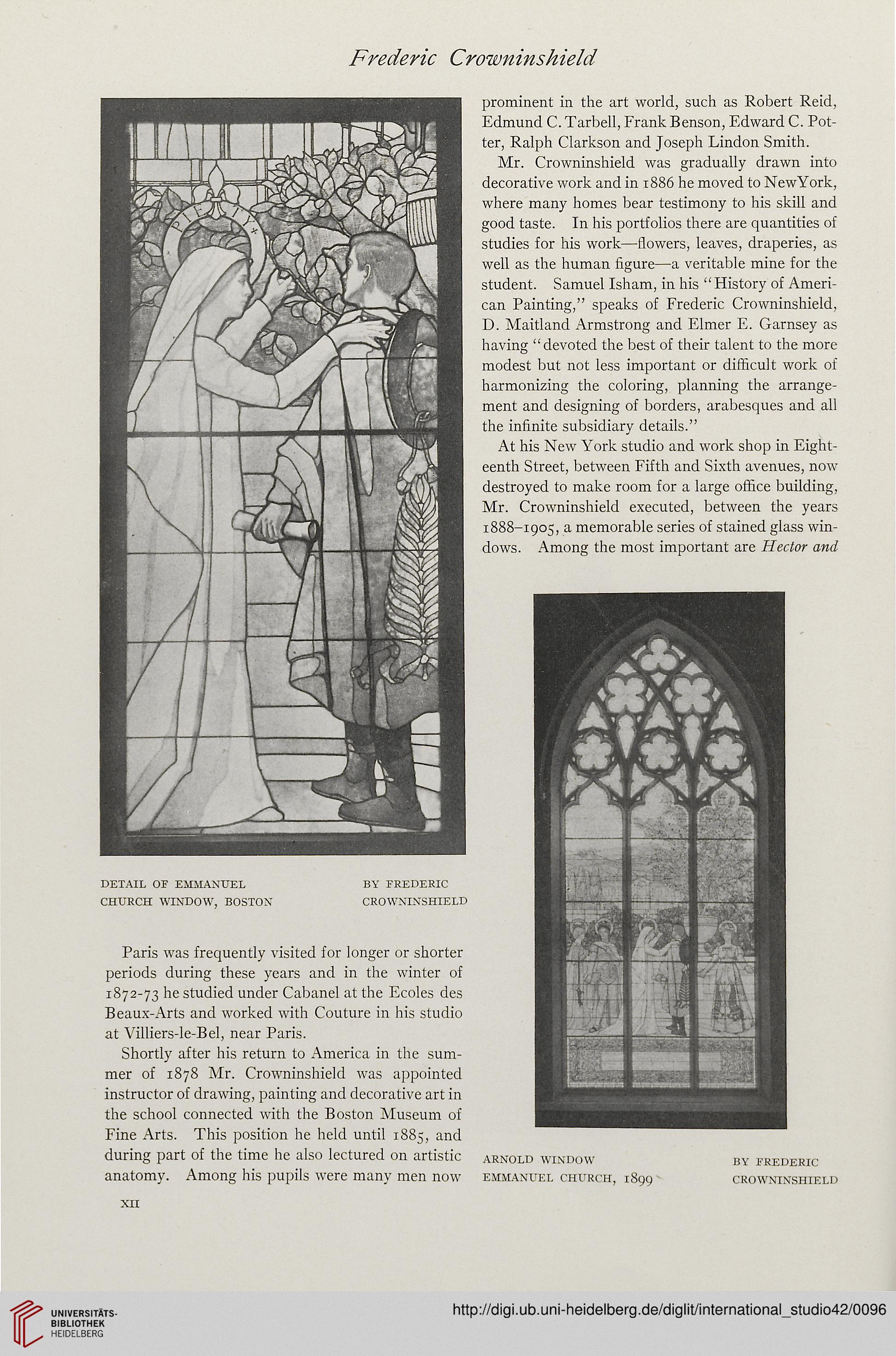Frederic Crowninshield
prominent in the art world, such as Robert Reid,
Edmund C. Tarbell, Frank Benson, Edward C. Pot-
ter, Ralph Clarkson and Joseph Lindon Smith.
Mr. Crowninshield was gradually drawn into
decorative work and in 1886 he moved to New York,
where many homes bear testimony to his skill and
good taste. In his portfolios there are quantities of
studies for his work—flowers, leaves, draperies, as
well as the human figure—a veritable mine for the
student. Samuel Isham, in his "History of Ameri-
can Painting," speaks of Frederic Crowninshield,
D. Maitland Armstrong and Elmer E. Garnsey as
having "devoted the best of their talent to the more
modest but not less important or difficult work of
harmonizing the coloring, planning the arrange-
ment and designing of borders, arabesques and all
the infinite subsidiary details."
At his New York studio and work shop in Eight-
eenth Street, between Fifth and Sixth avenues, now
destroyed to make room for a large office building,
Mr. Crowninshield executed, between the years
1888-1905, a memorable series of stained glass win-
dows. Among the most important are Hector and
detail of emmanuel by frederic
church window, boston crowninshield
Paris was frequently visited for longer or shorter
periods during these years and in the winter of
1872-73 he studied under Cabanel at the Ecoles des R
Beaux-Arts and worked with Couture in his studio
at Villiers-le-Bel, near Paris.
Shortly after his return to America in the sum-
mer of 1878 Mr. Crowninshield was appointed
instructor of drawing, painting and decorative art in
the school connected with the Boston Museum of
Fine Arts. This position he held until 1885, and
during part of the time he also lectured on artistic arnold window
by frederic
anatomy. Among his pupils were many men now Emmanuel church, 1899v crowninshield
xii
prominent in the art world, such as Robert Reid,
Edmund C. Tarbell, Frank Benson, Edward C. Pot-
ter, Ralph Clarkson and Joseph Lindon Smith.
Mr. Crowninshield was gradually drawn into
decorative work and in 1886 he moved to New York,
where many homes bear testimony to his skill and
good taste. In his portfolios there are quantities of
studies for his work—flowers, leaves, draperies, as
well as the human figure—a veritable mine for the
student. Samuel Isham, in his "History of Ameri-
can Painting," speaks of Frederic Crowninshield,
D. Maitland Armstrong and Elmer E. Garnsey as
having "devoted the best of their talent to the more
modest but not less important or difficult work of
harmonizing the coloring, planning the arrange-
ment and designing of borders, arabesques and all
the infinite subsidiary details."
At his New York studio and work shop in Eight-
eenth Street, between Fifth and Sixth avenues, now
destroyed to make room for a large office building,
Mr. Crowninshield executed, between the years
1888-1905, a memorable series of stained glass win-
dows. Among the most important are Hector and
detail of emmanuel by frederic
church window, boston crowninshield
Paris was frequently visited for longer or shorter
periods during these years and in the winter of
1872-73 he studied under Cabanel at the Ecoles des R
Beaux-Arts and worked with Couture in his studio
at Villiers-le-Bel, near Paris.
Shortly after his return to America in the sum-
mer of 1878 Mr. Crowninshield was appointed
instructor of drawing, painting and decorative art in
the school connected with the Boston Museum of
Fine Arts. This position he held until 1885, and
during part of the time he also lectured on artistic arnold window
by frederic
anatomy. Among his pupils were many men now Emmanuel church, 1899v crowninshield
xii




